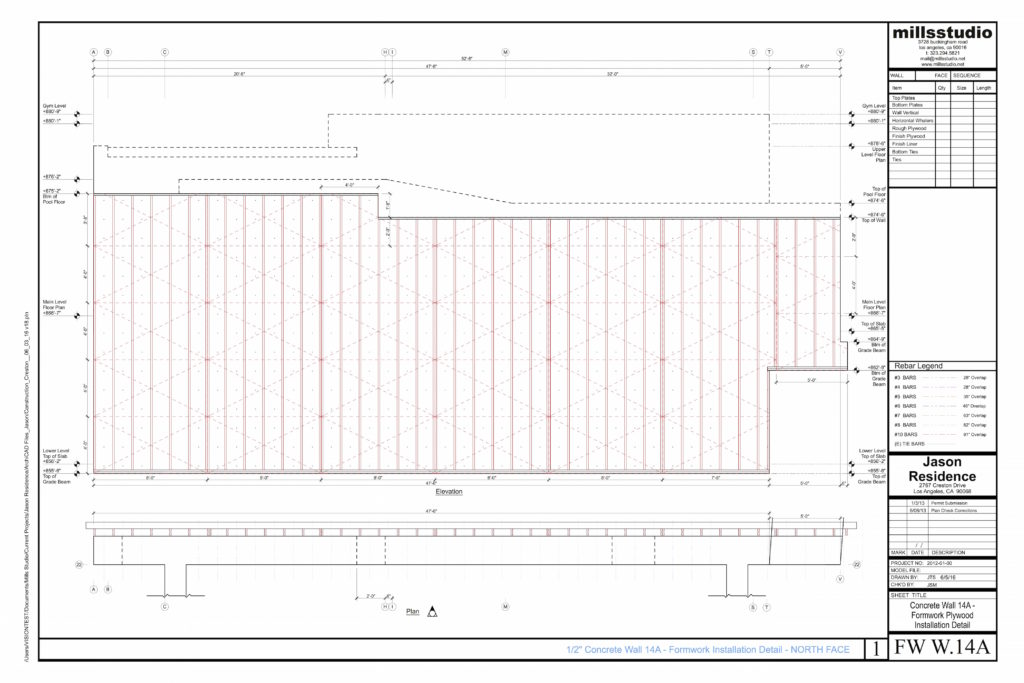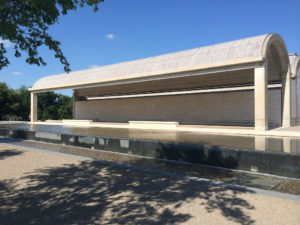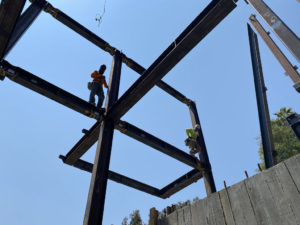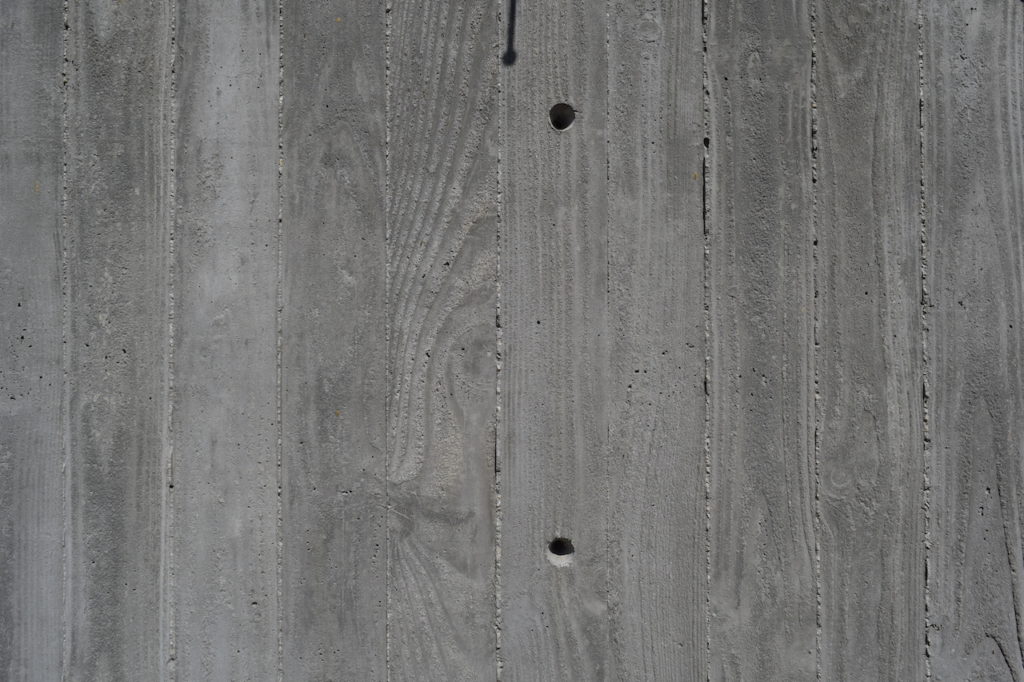Use the best materials and reveal the qualities of those materials and the craftsmanship of their assembly.
~ Karl Friedrich Schinkel
Material Palette
Along with space and structure, materials make architectural intent tangible. An authentic architecture, as differentiated from a fashionable architecture, better maintains its expressive power over time by appropriately using elemental materials as the physical raw character and inherent primal power of materials changes little over time or with circumstance. The juxtaposition of materials can clarify and accentuate the elemental properties and attributes of individual materials. Thus, it is often the intentional juxtaposition of materials that best expresses the architectural purpose. Materials act as both ends in themselves, and shape and are shaped by the community of materials they are a part of.
Stone, concrete, wood, and brick are the most elemental and ancient materials that have been used for thousands of years to make buildings and steel and glass are the materials most associated with making “modern architecture.” Today’s buildings of lasting significance are able to reconcile the use of ancient and modern materials connecting the architectural experience simultaneously to the past (tradition) and present (modern). Architecture connecting the user to past and present resonates because a balanced, healthy life reconciles tradition and innovation. No modern architect was better able to use materials to make buildings that help us simultaneously relate to the world both as it is (modern) and as it has been (tradition) than Louis Kahn in buildings such as the Salk Institute of 1972 and the Kimbell Art Museum of 1960.
Equally important to the use of a particular material is how it is used. Materials have different natures that must be clarified and expressed in the construction of a building if the building is to become architecture. A material’s structural properties, aesthetic character, and cultural values (assuming its cultural values rightly follow from its structural properties and aesthetic character) give a material its nature that construction must clarify. The reverse is also true, that appropriately used materials will clarify the construction and show how a building is made. Again, Louis Kahn best expressed this understanding of the connection between construction and materials, stating when the construction process is clearly evident it “shows the decision of materials.”
There’s a tendency to suggest that there are immanent qualities in the materials that are used in building and design; the materials are often defined from within, instead of through the user’s experience of them. The art world has left this conservative notion behind….
~ Olafur EliassonAlthough, materials are what we use to express an architectural agenda and the purposes of architecture in building form, the use of a particular material is never an architectural agenda, an idea, or a purpose of architecture. Making a concrete or a wood building is never a purpose or an architectural agenda. It is the implementation of a purpose and an architectural agenda. It is never sufficient to just appropriately express the inherent qualities of a material, but this must be done in the service of expressing the ideas that are the purposes of architecture. The choice and use of a material can never feel or appear arbitrary as one of the purposes of architecture is to fight against the modern idea that man’s fate is arbitrary. Every material has the potential and responsibility to work toward the expression of an intentional purpose.
If we understand the nature of a material, we have to be able to understand the structure of wood, the weight and the hardness of stone…we must become one with our materials and be able to fashion and use them in accordance with their constitution.
~ Jorn Utzon
DTS Evaluation Criteria
A clear architectural agenda establishes the criteria for evaluating and judging material choices and how materials are installed. Every material and combination of materials either contributes or detracts from the expressed clarity of the architectural agenda. In no particular order, the criteria for choosing the material palette for the DTS Project House includes:
- Ability to contribute to mills studio’s architectural agenda
- Ability to provide clarity to the design concept and building structure
- Durability and required maintenance
- Amount of required finishing
- Ability to patina and age gracefully
- Aesthetic qualities
- Ability to contribute to sustainability goals
- Ability to contribute to innovation and new potentialities
- How its proposed installation would align with its inherent properties
- Cost of material and its installation
- Tactile experience and how affects all five senses
- How contributes to occupant’s well being
- How aligns with logistics of construction such as available labor and site access
Each contemplated material was evaluated first as an end in itself with judgements of its inherent properties, aesthetic qualities, and applied cultural content, and then evaluated on how its use in combination with the other materials would express mills studio’s architectural agenda. Each material considered must work as a separate part and as part of a whole where a material’s affect is often felt because of its relationship to other materials. In order to clearly express the architectural agenda and architecture’s purposes, how a material is used or installed is even more important than the material choice itself. Materials with little aesthetic value can be elevated with the appropriate installation and a material’s beauty can be destroyed with an inappropriate installation. Thus, evaluation of any material must include evaluation of how it will be installed.
Prior to the Industrial Revolution, half-production methods were abundant. Craft defined everything. The craftsman had an almost phenomenological knowledge of materials and intuited how to vary their properties according to their structural and environmental characteristics.
~ Nuri Oxman
DTS Material Palette
Concrete and steel are the two most important material choices to the experience of the DTS Project House. The heavy, earthbound, board formed concrete retains the earth and provides a physical and visual base for the light, floating, painted steel framed glass boxes. The juxtaposition of the organic, crafted, poured concrete walls and the precise, manmade, assembled steel is an expression of the many dualities that the DTS Project House attempts to reconcile: city and garden; community and individual, standards and freedom; natural and manmade; crafted and assembled; whole and part; ancient and modern; compression and tension; light and shade; integrated and articulated; in situ and prefabricated; protection and liberation; tradition and new. The physical, visual, and cultural properties of the two materials are used to fulfill one of architecture’s purposes: reconciling many of life’s necessary dynamic dualities.

The other important material choice is the rock filled gabion outer protective walls that physically and conceptually anchor the house to its hillside site. The way in which this durable, organic, earth material “protects” the precious, refined, man-made steel and glass boxes is another of the expressed material juxtapositions that gives the DTS Project House its form, its aesthetic, and its spatial experience. The physical realities of this material choice and installation method also expresses the purpose of the family institution – to provide the necessary filter between the individual and the community.
The meaning of artifacts [materials] lies in the particularities of use.
~ Ludwig WittgensteinThe further DTS Project House building material palette includes rammed earth; metals including rusted corten steel, blackened steel, brushed stainless steel, zincalume, and powder coated metal fabrications; integrally colored acid washed concrete; clear anodized aluminum doors and windows; clear and fritted glass; woods including clear sealed mahogany, Brazilian cherry, and douglas fir; stainless steel cable; translucent acrylic and polycarbonate panels; ledger stone; and felt and shear weave fabrics.
Materials contribute to the sustainability goals in various ways with most materials contributing in multiple ways. Specific to sustainability, materials were considered and chosen for their durability, for their ability to age gracefully with little or no maintenance, for no need for applied finishing, for their energy saving or energy producing properties, and for their recycled content or ability to be recycled. The concrete is durable, a thermal mass, requires no applied finish, requires no maintenance, uses recycled flyash, and is fire and rodent proof. The rammed earth is also durable, requires no applied finish or maintenance, recycles the dirt on site, and is also fire and rodent fireproof. Corten and stainless steel are durable, age gracefully, require no applied finishes, contain recycled content and can be recycled. Aluminum doors and windows contain substantial recycled content and require no maintenance or applied finishes.
Everything we choose in life for its lightness soon reveals its unbearable weight.
~ Richard Serra
DTS MATERIALS and DTS CONSTRUCTION
Along with the materials, it is the way the materials are installed (the process of construction) that gives the DTS Project House its aesthetic and architectural experience. The DTS Project House looks the way it does as a result of the way it is built – it purposely shows the marks of its making. Although the aesthetic is the result of the construction process, this does not mean the result is accidental and not intentional. It means the construction process is designed, and the use of materials and construction process are properly in sync with each informing design decisions regarding the other.
The design of the construction process is one in the same as the design of the DTS Project House. Most every material in the finished building in some way shows the mark of construction, with many of the materials specifically chosen for the fact that the way they are installed determines their tangible tactile character. The exposed board formed concrete is a prime example.
Exposed concrete has its inherent properties, such as strength in compression, but its ultimate experiential character is determined by how it is installed – its formwork. The design of the concrete’s finish is the design of the formwork as the finish of concrete is the leftover mark of the formwork – formwork which will never be seen in the finished building. The leftover marks of the formwork are discretionary and were intentionally designed. The design of the formwork also accounts for and embraces the non-controllable aspects of pouring concrete in the Hollywood Hills, such as a concrete truck stuck in Los Angeles traffic or a car blocking the winding access road. A smooth concrete finish where imperfections appears as a blemishes was rejected in favor of a textured surface where “imperfections” are part of the character.

What I aim to achieve in architecture is not deterioration or degradation, but simply for materials to reveal, through the passage of time, a more sublime face with a more lustrous patina.
~ Hiroshi Sugimoto




